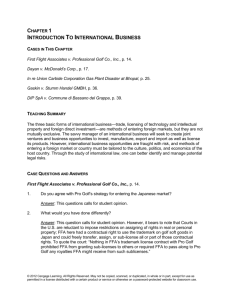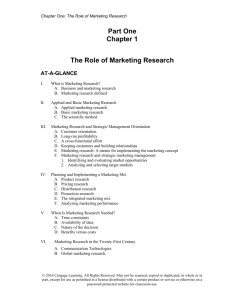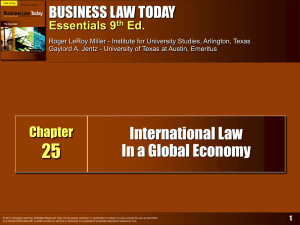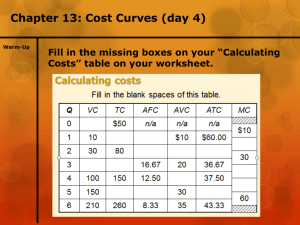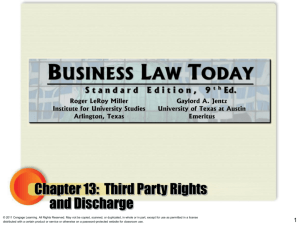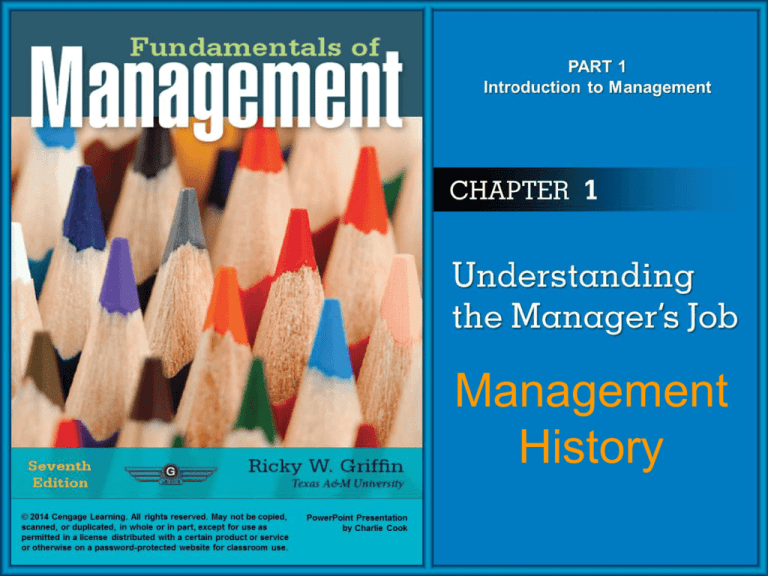
Management
History
The Importance of Theory and History
• Why Theory?
–Provides a conceptual framework for organizing
knowledge and providing a blueprint for action.
• Management theories are grounded in reality.
• Managers develop their own theories.
• Why History?
–An awareness and understanding of historical
developments in management are important.
• Furthers development of management practices.
• Avoids mistakes of others in the past.
© 2014 Cengage Learning. All rights reserved. May not be copied, scanned, or duplicated, in whole or in part, except for use as
permitted in a license distributed with a certain product or service or otherwise on a password-protected website for classroom use.
1–2
Where did Management definitions come
from?
• The attainment of organizational goals in an
effective and efficient manner through:
Planning,
Organizing,
Leading, and
Controlling of organizational resources.
© 2014 Cengage Learning. All rights reserved. May not be copied, scanned, or duplicated, in whole or in part, except for use as
permitted in a license distributed with a certain product or service or otherwise on a password-protected website for classroom use.
1–3
Management History
BIG QUESTION OF THE DAY: We didn’t just begin with a
complicated definition of management. What are the origins of
our thinking about management?
“A historical perspective on management provides a
context in which to interpret current opportunities and
problems”
Why do our perspectives on Management
change over time?
• Social Forces
• Political Forces
• Economic Forces
1–4
The Historical Context of Management
D Greeks
C Babylonians
G Venetians
B Egyptians
E Romans
A Sumerians
3000B.C.
2500B.C.
F Chinese
2000B.C.
1500B.C.
1000B.C.
500 B.C.
A.D.500
A.D.1000
A.D.1500
A Used written rules and regulations for governance
E Used organized structure for communication and control
B Used management practices to construct pyramids
F Used extensive organization structure for government
agencies and the arts
C Used extensive set of laws and policies for governance
D Used different governing systems for cities and state
G Used organization design and planning concepts to
control the seas
© 2014 Cengage Learning. All rights reserved. May not be copied, scanned, or duplicated, in whole or in part, except for use as
permitted in a license distributed with a certain product or service or otherwise on a password-protected website for classroom use.
1–5
Early Management Influences
• Robert Owen (1771–1858)
–Recognized the importance of human resources and
the welfare of workers.
• Charles Babbage (1792–1871)
• Focused on creating production efficiencies through
division of labor, and application of mathematics to
management problems.
• The Industrial Revolution
–Adam Smith, The Wealth of Nations (1776)
• Division of Labor
• Work Specialization
© 2014 Cengage Learning. All rights reserved. May not be copied, scanned, or duplicated, in whole or in part, except for use as
permitted in a license distributed with a certain product or service or otherwise on a password-protected website for classroom use.
1–6
Robert Owen
© 2014 Cengage Learning. All rights reserved. May not be copied, scanned, or duplicated, in whole or in part, except for use as
permitted in a license distributed with a certain product or service or otherwise on a password-protected website for classroom use.
1–7
© 2014 Cengage Learning. All rights reserved. May not be copied, scanned, or duplicated, in whole or in part, except for use as
permitted in a license distributed with a certain product or service or otherwise on a password-protected website for classroom use.
1–8
Charles Babbage
© 2014 Cengage Learning. All rights reserved. May not be copied, scanned, or duplicated, in whole or in part, except for use as
permitted in a license distributed with a certain product or service or otherwise on a password-protected website for classroom use.
1–9
Our Focus on MGT History
© 2014 Cengage Learning. All rights reserved. May not be copied, scanned, or duplicated, in whole or in part, except for use as
permitted in a license distributed with a certain product or service or otherwise on a password-protected website for classroom use.
1–10
The Classical Management Perspective
• Scientific Management – Taylor & Gilbreths
–Concerned with improving the performance of
individual workers (i.e., efficiency).
–Grew out of the industrial revolution’s labor shortage.
• Administrative Management - Fayol & Weber
–Focuses on managing
the total organization
rather than individuals.
© 2014 Cengage Learning. All rights reserved. May not be copied, scanned, or duplicated, in whole or in part, except for use as
permitted in a license distributed with a certain product or service or otherwise on a password-protected website for classroom use.
1–11
Scientific Management
• Frederick Taylor (1856–1915)
–Replaced old work methods with scientifically-based
work methods.
• Eliminated “soldiering,” where employees deliberately worked
at a pace slower than their capabilities.
–Believed in selecting, training, teaching, and
developing workers.
–Used time studies of jobs, standards planning,
exception rule of management, slide-rules, instruction
cards, and piece-work pay systems to control and
motivate employees.
© 2014 Cengage Learning. All rights reserved. May not be copied, scanned, or duplicated, in whole or in part, except for use as
permitted in a license distributed with a certain product or service or otherwise on a password-protected website for classroom use.
1–12
FIGURE 1.3
Steps in Scientific Management
© 2014 Cengage Learning. All rights reserved. May not be copied, scanned, or duplicated, in whole or in part, except for use as
permitted in a license distributed with a certain product or service or otherwise on a password-protected website for classroom use.
1–13
Taylor’s Scientific Management
Fred Taylor's Scientific Management
1.Taylor’s Scientific
Management becomes
the foundation for what
common manufacturing
technique that is still
used today?
2.What were the
advantages of scientific
management?
3.Disadvantages?
© 2014 Cengage Learning. All rights reserved. May not be copied, scanned, or duplicated, in whole or in part, except for use as
permitted in a license distributed with a certain product or service or otherwise on a password-protected website for classroom use.
1–14 m
Scientific Management Pioneers
• Frank and Lillian Gilbreth
–Both developed techniques and
strategies for eliminating inefficiency.
• Frank reduced bricklaying movements,
resulting in increased output of 200%.
• Lillian made substantive contributions
to the fields of industrial psychology
and personnel management.
Frank and Lillian Gilbreth Video
1. Are Frank and Lillian Gilbreth’s techniques
still used today?
2. What are the “Therbligs”?
1–15
© 2014 Cengage Learning. All rights reserved. May not be copied, scanned, or duplicated, in whole or in part, except for use as
permitted in a license distributed with a certain product or service or otherwise on a password-protected website for classroom use.
1–16
Administrative Management Theorists
• Henri Fayol (1845–1925)
–Identified the specific management functions of
planning, organizing, leading, and controlling.
• Max Weber (1864–1920)
–His theory of bureaucracy is based on a rational set of
guidelines for structuring organizations.
© 2014 Cengage Learning. All rights reserved. May not be copied, scanned, or duplicated, in whole or in part, except for use as
permitted in a license distributed with a certain product or service or otherwise on a password-protected website for classroom use.
1–17
Fayol’s 14 Principles of Management
© 2014 Cengage Learning. All rights reserved. May not be copied, scanned, or duplicated, in whole or in part, except for use as
permitted in a license distributed with a certain product or service or otherwise on a password-protected website for classroom use.
1–18
Weber’s Bureaucracy
The most efficient way of organizing a business?
1.
2.
3.
© 2014 Cengage Learning. All rights reserved. May not be copied, scanned, or duplicated, in whole or in part, except for use as
permitted in a license distributed with a certain product or service or otherwise on a password-protected website for classroom use.
Name a truly
efficient
bureaucratic
organization?
Why aren’t
many
bureaucracies
efficient?
Which rules
do they
break?
1–19
Classical Management Perspective
• Contributions
–Laid foundation for later
developments.
–Identified important
management
processes, functions,
and skills.
–Focused attention on
management as subject
of scientific inquiry.
• Limitations
–More appropriate for
use in traditional,
stable, simple
organizations.
–Prescribed universal
procedures that are not
appropriate in some
settings.
–Employees viewed as
tools rather than as
resources.
© 2014 Cengage Learning. All rights reserved. May not be copied, scanned, or duplicated, in whole or in part, except for use as
permitted in a license distributed with a certain product or service or otherwise on a password-protected website for classroom use.
1–20
Behavioral Management Perspective
• Behavioral Management
–Emphasized the importance of individual attitudes and
behaviors, and group processes.
• Hugo Munsterberg (1863–1916)
–Advocated applying psychological concepts to
employee selection and motivation.
• Mary Parker Follett (1868–1933)
–Recognized importance of human behavior in the
workplace.
– Management is: “the art of getting things done
through people”
© 2014 Cengage Learning. All rights reserved. May not be copied, scanned, or duplicated, in whole or in part, except for use as
permitted in a license distributed with a certain product or service or otherwise on a password-protected website for classroom use.
1–21
Key Managerial Roles (Munsterberg)
Key Management
Roles
Interpersonal
Roles
Informational
Roles
Decisional
Roles
• Figurehead
• Leader
• Liaison
• Monitor
• Disseminator
• Spokesperson
• Entrepreneur
• Disturbance handler
• Negotiator
© 2014 Cengage Learning. All rights reserved. May not be copied, scanned, or duplicated, in whole or in part, except for use as
permitted in a license distributed with a certain product or service or otherwise on a password-protected website for classroom use.
1–22
The Hawthorne Studies (1927–1932)
• Conducted at Western Electric
The Hawthorne Studies Video
–Illumination study
• Lighting adjustments affected both control and experimental
groups of employees.
–Group study – Relay assembly test room experiments
and the Bank wiring room experiments
• Incentive plans and lack of supervision caused workers to
establish informal levels of individual output.
– Over-producing workers were labeled “rate busters.”
– Under-producing workers were considered “chiselers.”
–Interview program
• Confirmed importance of human behavior in the workplace.
© 2014 Cengage Learning. All rights reserved. May not be copied, scanned, or duplicated, in whole or in part, except for use as
permitted in a license distributed with a certain product or service or otherwise on a password-protected website for classroom use.
1–23
Behavioral Management Evolves
• The Human Relations Movement
–Grew out of the Hawthorne studies.
• What is the Hawthorne Effect?
–Proposed that workers respond primarily to the social
context of work, including social conditioning, group
norms, and interpersonal dynamics.
–Assumed that the manager’s concern for workers
would lead to increased worker satisfaction and
improved worker performance.
© 2014 Cengage Learning. All rights reserved. May not be copied, scanned, or duplicated, in whole or in part, except for use as
permitted in a license distributed with a certain product or service or otherwise on a password-protected website for classroom use.
1–24
Human Relations View of Management
Individual Needs and Motives
Supervisor
Social
Context
Task
Individual
Responses
© 2014 Cengage Learning. All rights reserved. May not be copied, scanned, or duplicated, in whole or in part, except for use as
permitted in a license distributed with a certain product or service or otherwise on a password-protected website for classroom use.
1–25
Behavioral Management Theorists
• Abraham Maslow
–Advanced a theory that employees are motivated
by a hierarchy of needs that they seek to satisfy.
• Douglas McGregor
–Proposed Theory X and Theory Y concepts
of managerial beliefs about people and work.
© 2014 Cengage Learning. All rights reserved. May not be copied, scanned, or duplicated, in whole or in part, except for use as
permitted in a license distributed with a certain product or service or otherwise on a password-protected website for classroom use.
1–26
Maslow’s Hierarchy of Needs
1. What motivates
human behavior?
2. Why the triangle?
3. What are lower level
needs?
4. How do needs become
fulfilled?
5. Will a met need
motivate?
6. Can work/your job
serve to fulfill these
needs?
© 2014 Cengage Learning. All rights reserved. May not be copied, scanned, or duplicated, in whole or in part, except for use as
permitted in a license distributed with a certain product or service or otherwise on a password-protected website for classroom use.
1–27
Table 1.1
Theory X and Theory Y
Theory X
Assumptions
1. People do not like work and try to avoid it.
2. People do not like work, so managers have to control, direct, coerce,
and threaten employees to get them to work toward organizational
goals.
3. People prefer to be directed, to avoid responsibility, and to want
security; they have little ambition.
Theory Y
Assumptions
1. People do not naturally dislike work; work is a natural part of their lives.
2. People are internally motivated to reach objectives to which they are
committed.
3. People are committed to goals to the degree that they receive personal
rewards when they reach their objectives.
4. People will both seek and accept responsibility under favorable
conditions.
5. People have the capacity to be innovative in solving organizational
problems.
6. People are bright, but under most organizational conditions their
potential is underutilized.
© 2014 Cengage Learning. All rights reserved. May not be copied, scanned, or duplicated, in whole or in part, except for use as
permitted in a license distributed with a certain product or service or otherwise on a password-protected website for classroom use.
1–28
Organizational Behavior (OB)
• Focuses on behavioral perspectives.
–Draws on psychology, sociology, anthropology,
economics, and medicine.
–Has a contingency orientation.
• Important OB research topics:
–Job satisfaction and job stress
–Motivation and leadership
–Group dynamics and organizational politics
–Interpersonal conflict
–The structure and design of organizations
© 2014 Cengage Learning. All rights reserved. May not be copied, scanned, or duplicated, in whole or in part, except for use as
permitted in a license distributed with a certain product or service or otherwise on a password-protected website for classroom use.
1–29
Behavioral Management Contributions
• Provided insights into motivation, group
dynamics, and other interpersonal processes.
• Focused managerial attention on these critical
processes.
• Challenged the view that employees are tools
• Furthered the belief that employees are valuable
resources.
© 2014 Cengage Learning. All rights reserved. May not be copied, scanned, or duplicated, in whole or in part, except for use as
permitted in a license distributed with a certain product or service or otherwise on a password-protected website for classroom use.
1–30
Behavioral Management Limitations
• Complexity of individuals makes behavior
difficult to predict.
• Many concepts not put to use because
managers are reluctant to adopt them.
• Contemporary research findings are not often
communicated to practicing managers in an
understandable form.
© 2014 Cengage Learning. All rights reserved. May not be copied, scanned, or duplicated, in whole or in part, except for use as
permitted in a license distributed with a certain product or service or otherwise on a password-protected website for classroom use.
1–31
The Quantitative Management Perspective
• Quantitative Management
–Helped Allied forces manage logistical
problems during World War II.
–Focuses on decision making, economic
effectiveness, mathematical models, and
use of computers to solve quantitative
problems.
© 2014 Cengage Learning. All rights reserved. May not be copied, scanned, or duplicated, in whole or in part, except for use as
permitted in a license distributed with a certain product or service or otherwise on a password-protected website for classroom use.
1–32
Quantitative Management Fields
• Management Science
–Focuses on the development of representative
mathematical models to assist with decisions.
• Operations Management
–Practical application of management
science to efficiently manage the
production and distribution
of products and services.
© 2014 Cengage Learning. All rights reserved. May not be copied, scanned, or duplicated, in whole or in part, except for use as
permitted in a license distributed with a certain product or service or otherwise on a password-protected website for classroom use.
1–33
Quantitative Management Contributions
• Developed sophisticated
quantitative techniques to
assist in decision making.
–Models are useful in
understanding complex
processes and situations.
• Useful in planning and
controlling processes.
• Influenced fields of
industrial engineering, BIS,
Production Management,
Industrial Management.
© 2014 Cengage Learning. All rights reserved. May not be copied, scanned, or duplicated, in whole or in part, except for use as
permitted in a license distributed with a certain product or service or otherwise on a password-protected website for classroom use.
1–34
Quantitative Management Limitations
• Cannot fully explain or predict
behavior of people in
organizations.
• Mathematical sophistication
may displace other
managerial skills.
• Uses models that may
require
unrealistic or unfounded
assumptions, limiting their
general applicability.
1–35
FIGURE 1.4
The Systems Perspective of Organizations
Based on interaction
with the external
ENVIRONMENT of the
system
© 2014 Cengage Learning. All rights reserved. May not be copied, scanned, or duplicated, in whole or in part, except for use as
permitted in a license distributed with a certain product or service or otherwise on a password-protected website for classroom use.
1–36
Systems Perspective Concepts
• Open System
–An organizational system that
interacts with its environment.
• Closed system
–An organizational system that does
not interact with its environment.
• Subsystems
–A system within another system
that is important due to its
interdependence on other subsystems within the organization.
© 2014 Cengage Learning. All rights reserved. May not be copied, scanned, or duplicated, in whole or in part, except for use as
permitted in a license distributed with a certain product or service or otherwise on a password-protected website for classroom use.
1–37
Systems Perspective Concepts (cont’d)
• Synergy
–Subsystems are more successful working
together in than working alone.
–The whole system (subsystems working together
as one system) is more productive and efficient
than the sum of its parts. The whole is greater than
the sum of the parts. Explain that math.
• Entropy
–Is a process in which an organizational system
declines due to failing to adjust to change in its
environment.
–Is avoided through change and renewal.
© 2014 Cengage Learning. All rights reserved. May not be copied, scanned, or duplicated, in whole or in part, except for use as
permitted in a license distributed with a certain product or service or otherwise on a password-protected website for classroom use.
1–38
Systems Theory in Practice
McDonald’s as a System
Explain McDonald’s French Fry Process based
on Systems Theory:
1. What are the inputs?
2. Describe the transformation process?
3. What are the outputs?
4. What type of feedback might McDonald’s
receive from the environment?
5. How might this feedback alter the
management decisions about the french fry
process in the future?
6. What could happen if McDonald’s
management ignores the feedback from the
environment and fails to adapt its process?
7. System or subsystem?
© 2014 Cengage Learning. All rights reserved. May not be copied, scanned, or duplicated, in whole or in part, except for use as
permitted in a license distributed with a certain product or service or otherwise on a password-protected website for classroom use.
1–39
The Contingency Perspective
• Universal Perspectives
–Include classical, behavioral, and quantitative
approaches
–Attempt to identify “one best way” to manage
organizations.
• Contingency Perspective
–Suggests each organization is unique.
• Appropriate managerial behavior
depends (is contingent) on current
situation in the organization.
© 2014 Cengage Learning. All rights reserved. May not be copied, scanned, or duplicated, in whole or in part, except for use as
permitted in a license distributed with a certain product or service or otherwise on a password-protected website for classroom use.
1–40
The Contingency Perspective Process
Problem or Situation
Important
Contingencies
Solution or Action
A
Solution or Action
B
Solution or Action
C
© 2014 Cengage Learning. All rights reserved. May not be copied, scanned, or duplicated, in whole or in part, except for use as
permitted in a license distributed with a certain product or service or otherwise on a password-protected website for classroom use.
1–41
An Integrative Framework of
Management Perspectives
Systems Approach
• Recognition of internal
interdependencies
• Recognition of
environmental influences
Classical
Management
Perspectives
Methods for
enhancing
efficiency and
facilitating planning,
organizing, and
controlling
Contingency Perspective
• Recognition of the situational
nature of management
• Response to particular
characteristics of situation
Behavioral
Management
Perspectives
Insights for motivating performance
and understanding
individual behavior,
groups and teams,
and leadership
Quantitative
Management
Perspectives
Techniques for
improving decision
making, resource
allocation, and
operations
Effective and efficient management
© 2014 Cengage Learning. All rights reserved. May not be copied, scanned, or duplicated, in whole or in part, except for use as
permitted in a license distributed with a certain product or service or otherwise on a password-protected website for classroom use.
1–42
Why does Management History Matter?
1. Do we use Scientific Management today?
Where? Why?
2. Do we use Bureaucracy today? Where?
Why?
3. Do we use the Human Perspective/
Behavioral Management today? Where?
Why?
4. Management science? Systems theory?
5. So why does Management History Matter?
It’s part of the workplace you will manage
TODAY.
© 2014 Cengage Learning. All rights reserved. May not be copied, scanned, or duplicated, in whole or in part, except for use as
permitted in a license distributed with a certain product or service or otherwise on a password-protected website for classroom use.
1–43




